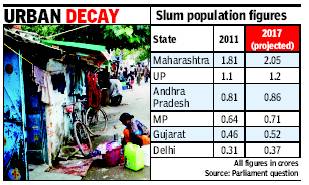Slums: India
| Line 9: | Line 9: | ||
See [[examples]] and a tutorial.</div> | See [[examples]] and a tutorial.</div> | ||
|} | |} | ||
| − | [[Category:India |S]] | + | [[Category:India|S]] |
| − | [[Category: Development |S]] | + | [[Category:Development|S]] |
[[Category:Name|Alphabet]] | [[Category:Name|Alphabet]] | ||
[[Category:Name|Alphabet]] | [[Category:Name|Alphabet]] | ||
Revision as of 17:00, 7 March 2014
This is a collection of articles archived for the excellence of their content. Readers will be able to edit existing articles and post new articles directly |
Slum-free India? No chance
By 2017, Population Will Rise To 104m, Maha Will Top Chart
Dipak Kumar Dash | TNN
The Times of India 2013/08/21
New Delhi: India’s slum population will surge to 104 million by 2017 — or around 9% of the total projected national population of 1.28 billion that year.
This means urban planners will face escalating challenges as these slums will mostly proliferate in sleepy towns and in semi-rural areas, a consequence of an accelerating rural to urban shift across the nation.
According to data provided in Parliament, Maharashtra, Uttar Pradesh, Andhra Pradesh and Madhya Pradesh will host the largest chunks of India’s slum population (see box).
In a reply to a starred question by Nashik MP Sameer Bhujbal last week in Parliament, the government offered a projection of the slum population on the basis of the Pranab Sen Committee report submitted in 2010. The committee’s previous projection of slum population in 2011 was 93 million, or 7% of a total population of 1.21 billion.
But the census of 2011 recorded 1.3 crore urban slum households. So, if a household is estimated at five members, the urban slum population would be around 65 million. This 65 million figure is considerably lower than the Sen Committee’s projection of 93 million slum dwellers in 2011 (based on the 2001 census).
The 2011 census shows the problem is growing as it indicates the percentage of people living in slums in smaller cities with a population of less than a million is rising. While 62% people in these cities are slum dwellers, it is 38% in all million-plus cities that include mega metros like Delhi and Mumbai.
In absolute numbers while million-plus cities have 52 lakh slum households, the count is 85 lakh in the sub-million cities. “We are creating a bigger problem by failing to manage both bigger and smaller cities. Places like Khurja and Bulandshahr close to Delhi have become slums due to faulty planning and poor programme implementation. We can’t allow unchecked and unplanned urban growth. Governments must understand this and take steps keeping aside their political reasons,” said H R Suri, former head of Institute of Town Planners India.
Census data also shows how a large section of the urban population lives in slums in the four metropolitan cities — as high as 41.3% in Greater Mumbai, 29.6% in Kolkata, 28% in Chennai and about 15% in Delhi.
The socio-economic implications of a large slum population — which includes the cost of civic services, housing and health care, and increased crime and social tensions — saw the UPA government frame the Rajiv Awas Yojna as a policy response. The scheme is intended to provide affordable housing to the poor and make urban areas slum free but so far these efforts have registered little progress in focus cities, including Delhi.
